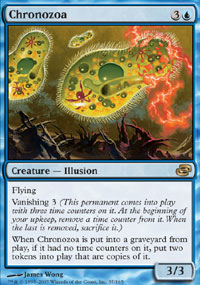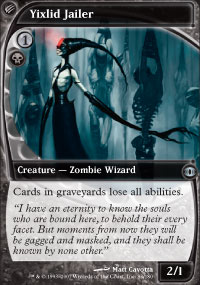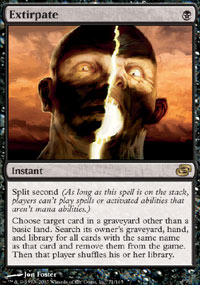
Cranial Insertion
Time Colander
or, There Sure Are a Lot of Magic Events This Summer
By Eli Shiffrin, Tom Fowler, and Ted Dickinson
Time Colander
or, There Sure Are a Lot of Magic Events This Summer
By Eli Shiffrin, Tom Fowler, and Ted Dickinson

Magic teaches you...
biology!
biology!
While I could probably dedicate an entire article to the wackiness of Grand Melee, we're going to sidestep most of that one since a large number of rules issues with Grand Melee are not fully supported by the Comprehensive Rules, and because Extended, Standard, and Time Spiral block questions are popping all over (and are currently or soon-to-be relevant!).
As always, send your best questions in to [email]cranial.insertion@gmail.com[/email] and we'll toss an exhilarating answer back to you, and very likely publish your question and the answer! For faster responses, rub your email with a banana.
Q: In response to my opponent's Chronozoa's "when you remove the last time counter, sacrifice this creature" trigger, I play Word of Seizing on it. Who gets the token copies when it's sacrificed?
A: Who said the Chronozoa is sacrificed? Surprise! Your little paramecium survives!
The vanishing trigger, controlled by your opponent, tells him to sacrifice Chronozoa. But since he doesn't control it, he can't sacrifice it. Since it doesn't die, it doesn't split up into babies, and it happily lives on long after it should be dead, much like Bob Barker.
Q: I've read of a strange misprint from an early Spanish set. It's either Time Elemental printed with the name, mana cost, card type, rules text, flavor text, and power/toughness of Serra Angel, or Serra Angel printed with the art and blue border of Time Elemental. Are extreme misprints like these allowed in sanctioned play?
A: As long as the card has a normal Magic back and isn't noticeably marked, the DCI has no problem with it. It has a normal Magic name - Serra Angel - so that's what it is. There are two caveats, though.
1) The head judge of an event may be very unhappy with your Time Angel. Check in advance if you plan to play with extreme misprints.
2) If you try to use the discrepancy between name and art to confuse opponents, that's a Very Bad Thing.
Q: I had a Windborn Muse and my opponent attacked with a Nacatl War-Pride making five tokens. Does he have to pay for each of those tokens to attack?
A: Windborn Muse only affects creatures being declared as attackers, and her payment demands are met in 308.2d-f, during the Declare Attacker step of combat. After that, she stops caring, and the War-Pride triggers in 308.2g when it becomes an attacking creature.
Q: What happens if you Delay Haakon, Stromgald Scourge?
A: He misses his train, gets mugged in the station, and dies poor and homeless on the concrete steps in the night. On Christmas Eve. In the snow.
Sad.
After his last time counter is removed, he finds himself sitting in the removed-from-game zone and being told to get his butt on the stack. But since he has that pesky ability that says that he can't be played except from the graveyard, he will refuse the suspend trigger that insists that he be played - "can't" wins out here. And thus does he sit in the removed-from-game zone for all eternity.

Magic teaches you...
fashion!
fashion!
A: Sure. He'll trigger even if the Jailer doesn't die. Check out rule 410.10d - "leaves-play" triggers check the game just before the event that causes an object to leave play, so even though Epochrasite is in the graveyard when the ability triggers, it'll look at its abilities from back when it was in play, where it had the "remove-from-game-with-counters" trigger.
Q: With combat damage on the stack, my opponent kills my Shadowmage Infiltrator. Do I still get to draw a card?
A: No card for you! The effect (resolving combat damage) will use the last-known information of the source of damage to determine the color of that source, to determine the type of that source, and the controller of that source, but it will not use last-known information to determine if that source had an ability. Since the Infiltrator is not in play with its happy card-drawing ability at the time damage is dealt, it can't trigger and you can't draw.
Q: My opponent put a -1/-1 counter on my Treetop Village with Serrated Arrows. What happens to the counter when my Treetop Village stops being a creature?
A: The -1/-1 counter will stick around on your land looking funny. Everyone should remember that rule 212.1b keeps +1/+1 counters on lands - it works just the same with -1/-1 counters, even though this situation is rather unusual.
Q: I'm thinking about what to play in my second main phase, and my opponent asked if he could play an instant while I think. I said okay, and he said he'd pass so it's the end of turn. That can't be legal, can it?
A: It's only legal in the sense that your opponent isn't committing an infraction. It's not legal in the sense that it's a valid trick to advance the turn sequence.
This sort of trick has been under debate for a long time, and responses have varied from "that's fine, players need to know how priority works" to "DQ for cheating," so the DCI has decided that there needs to be some level of consistency here. As a result, the September DCI document updates will include the Player Communication Policy and Shortcuts guide. They won't make every possible situation clear-cut, but they'll go a long way to establishing a line between bluffing and fraud.
Part of this policy says:
A player may not request priority and take no action with it. If they decide they do not wish to do anything, the request is nullified and priority is returned to the player that originally had it.
Want to see more? Make sure to check the DCI document center on the first of September to see the full policy updates! They'll be bundled in the Penalty Guidelines.
Q: Can I Stifle Phyrexian Dreadnought's "sacrifice creatures" trigger so I can keep him?
A: Phyrexian Dreadnought has a repl- what's this? Errata? Gasp!
For years and years and years, Phyrexian Dreadnought had a replacement effect and not a triggered ability. Now it has a triggered ability again, as originally printed. So congratulations, you can Stifle your Dreadnought to keep him around without sacrificing anything again. Have fun!
Q: I attack with a creature enchanted with Temporal Isolation and put combat damage on the stack. I know that if I get rid of the Temporal Isolation, I'll still get damage through, but what if I sacrifice or destroy my own creature instead of the Temporal Isolation?
A: You'll get the same result, only without keeping your creature. At the time that combat damage assignments resolve, there is no prevention effect telling the damage to stop, so the damage will happily smack your opponent in the face.
Q: Can I play Edge of Autumn even if I have a lot of lands just so I can raise my storm count?
A: You can indeed! The line "If you control four or fewer lands..." is not a play restriction, which would be worded "Play this only if..." It just means that Edge of Autumn will do nothing at all if you don't have few enough lands.
Q: Who can look at and/or smash open a face-down creature, the player who played it, or its controller? It matters if I Persuasion a morph from my opponent.
A: Only the controller of a face-down object can look at it or pay to turn it face up as per rules 504.3 and 502.26d.
Fun fact: Illusionary Mask also says that only the controller of the face-down creature can turn it up.
More fun facts: If you steal your opponent's creature, he can't look at it if he forgets what it was. He better take one good, hard look at it before you snatch it. He can ask for the Oracle wording of the card, though, if he remembers what it is but forgets the specifics of it.
Q: Can I cut into the madness process and Pull from Eternity the card so it can't be played?
A: Now there's a fun trick. Let's look at the wording of madness:
"Madness [cost]" means "If a player would discard this card, that player discards it, but may remove it from the game instead of putting it into his or her graveyard" and "When this card is removed from the game this way, its owner may play it by paying [cost] rather than paying its mana cost. If that player doesn't, he or she puts this card into his or her graveyard."
The second part of madness is what we want to look at here - what happens after the card ends up removed from the game. The word "when" signifies that we've got a triggered ability here! And since triggered abilities use the stack, we'll have a chance to respond to the trigger before it resolves and lets the spell be played.
The final nail in the coffin is rule 217.1c, which says that an object changing zones is a new object. Once we Pull the madness spell into the graveyard, it's a new object, one that the "wanna play that?" trigger won't let your opponent play.

Magic teaches you...
surgery!
surgery!
A: Willbender doesn't cause control of the Extirpate to change, so you'll still do the searching. Remember that whenever you search a hidden zone, you can fail to find cards if you're looking for a specific quality, like "the same name as that card."
So let's look at the zones you're searching.
Graveyard? It's revealed. You must remove all Dread Returns in your graveyard.
Hand? Extirpate doesn't cause you to reveal your hand! So your hand is still hidden, and you can choose not to find any Dread Returns in your hand.
Library? Very hidden. You don't have to find any there, either. You will have to shuffle your library, though, even if you choose not to physically search it at all.
Q: Is it legal to play a deck that does nothing but exploit the triple Faceless Butcher combo to draw the game every single game?
A: Players are required to advance the game to a conclusion, and that conclusion does not have to be a win. As long as you play at a reasonable pace, the DCI does not have a problem with a deck that tries to draw the game instead of winning it.
Your fellow players may be unhappy with your deck, though.
Remember that if they take it and set it on fire, that's Unsporting Conduct--Aggressive Behavior on their part.
Q: Will Momentary Blinking the last creature in play get rid of Porphyry Nodes?
A: Rule 410.11, and particularly its example, clarifies this one nicely. The Nodes have a state-triggered ability, and even though the battlefield is empty for only the briefest of moments, that's enough time for the Nodes to get depressed and decide to jump off a cliff. Without an intervening "if" clause (which would look rather silly on this ability), the game will not check to see if there are no creatures once the ability has triggered, and the poor Nodes will end its life even though a creature comes into play before its trigger resolves.
Q: If I make my opponent discard a Quagnoth, can I remove it from the game before he gets it back?
A: That sounds like a plan. Remember once again that "when" means it's a triggered ability and you can respond to it. Also remember that shroud won't be in effect unless the creature is in play, so targeting it in the graveyard is fair game.
Q: I don't want to untap my Centaur Omenreader. Can I leave him tapped during my untap step?
A: Rule 302.2 says that the active player "determines" which permanents untap, but don't stop there - it also says that normally, everything will untap, unless an effect keeps it tapped. You can't keep the Centaur tapped by force of will, so he must untap.
Q: I won one game, then my opponent won one game, and then I killed us both with Psionic Blast. Now what?
A: Now you start game four! Magic matches are not "best 2 out of 3," they are "first player to win two games wins the match."
And for some reason, an increasing number of cards lately have been printed that can easily draw games, so keep this tidbit in mind. It will probably matter at least once a tournament.
Q: My opponent has a Deep Sea Kraken with one time counter on it. I play Venser's Diffusion targeting it. What happens?
A: Oh hey, remember that "objects that change zone are new objects" rule from a few questions back? Here it comes again!
The Deep-Sea trigger ends up on top of the Diffusion, so it'll resolve first. The Kraken splashes into play, creating some tidal waves and smushing a couple innocent beach-goes, and then the Diffusion gets to resolve. Since the Kraken in play is a new object, the Diffusion's target is lost, and Diffusion is countered as it tries to resolve.
Q: If Vesuvan Shapeshifter turns up and copies something with vanishing, does it get counters? What would vanishing do if it doesn't?
A: Vanishing represents three abilities.
"This permanent comes into play with N time counters on it"
A Vesuvan Shapeshifter turning face up isn't coming into play, so this ability does nothing.
"At the beginning of your upkeep, if this permanent has a time counter on it, remove a time counter from it"
The "if" clause there will stop this ability from ever triggering, since the Shapeshifter has no counters on it. This assumes, of course, that time counters haven't been put on the Shapeshifter through some other method.
"When the last time counter is removed from this permanent, sacrifice it."
No time counters are being removed, so the "last" one won't ever be removed. In short, vanishing doesn't do anything at all if a Vesuvan Shapeshifter copies one turning face up, unless someone drops some time counters on it.
Q: If I turn a Vesuvan Shapeshifter face up copying a Maelstrom Djinn and then turn it face down again, what happens?
A: The triggered ability that gives the Shapeshifter counters and vanishing sets up a continuous effect that exists independent of the copy effect. Even though the copy effect ends when the Shapeshifter hides its face, the time counters stick around and it still has vanishing.
If you turn it face up copying the Djinn again, it'll get two more counters, and a second instance of vanishing! Each instance of vanishing will trigger separately, and you'll end up removing two counters per turn, leading the Shapeshifter to a quick and messy death -- you'll have two "sacrifice me" triggers to deal with instead of just one.
That's a wrap! We'll be back next week for yet another bundle of fun questions, possibly involving arcane teachings and forbidden lore. Or maybe just involving cardboard.
Until next time, enjoy the lessons Magic can teach you!
- Eli Shiffrin
Tucson, Arizona
Comments